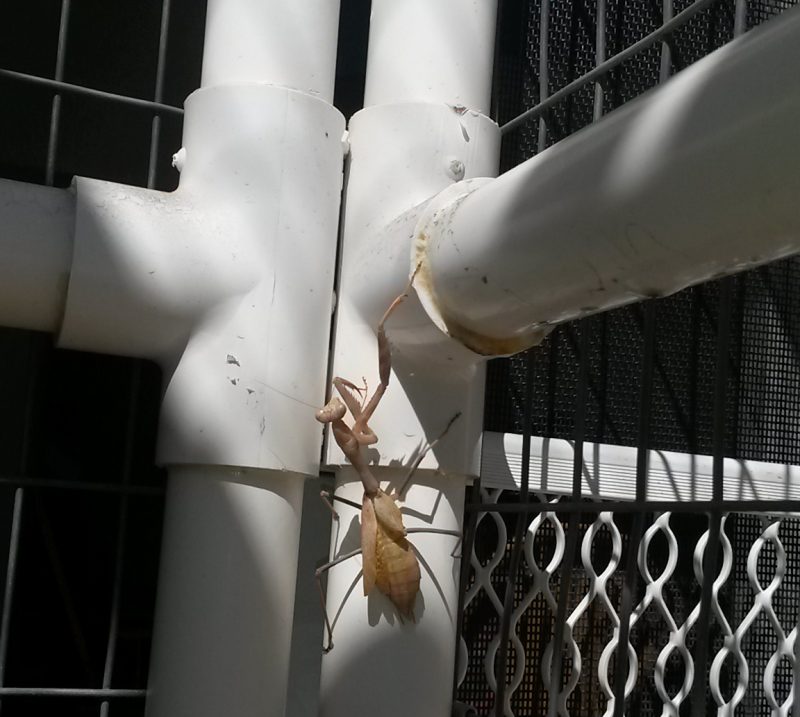The California Mantis lives from less than nine months up to one year maximum. I found the female mantis in this photograph on a plastic pipe and wire enclosure that sits flush with a sliding screen door at my house. The enclosure allows my cat to go outside when the screen door is open while protecting him from the venerable owls, coyotes and bobcats that we know live in the neighborhood. (Aside: If I want to keep a pet, much less a herd of exotic livestock, it is my responsibility to keep my pet indoors or ensure that his outdoor enclosure is predator-proof. Mountain lions, for example, already have plenty of human-caused challenges. They cannot become vegetarian or move somewhere else. If we do not respect and adapt to their instinctive behaviors because we can adapt, while they cannot, they will die out in southern California.)
Rant concluded, back to the mantis. She appeared on a morning in mid-October 2016 just after a couple days of significant rainfall. We do not receive much rain in southern California so it is remarkable when it occurs. The air was fresh and clear. You will notice that she appears to have done quite a bit of living. Her proto-thoracic armor is dented. One of her wings appears to be missing, with only a remnant of the leather outer wing covering remaining, the other wing and its covering look worn. She was clearly visible against the white pipe; if I could see her, then hungry birds would be able to see her as well. I moved her to a shrub where she might find some insects to eat and lay her ootheca, a protective protein-like material containing many eggs, if she had not already done so.
Young of the mantidae, or praying mantis family, go through an incomplete metamorphosis, meaning that they they do not go through larval and pupa stages, as does the Lepidoptera order of insects (butterflies and moths). While an adult butterfly looks nothing like its former larval self, mantis nymphs hatch looking like mini-adults. They are tiny at first and easily missed by the human eye. The mantis nymph molts a variable number of times depending on the species. Whenever it needs to grow, it molts. During one of these molts it emerges with a specialized ear that is located in its abdomen. This ear is especially developed to pick up the echolocation calls of bats, the ear cannot hear other tones. If it hears a bat in pursuit, it will attempt to escape by performing a complicated aerial maneuver that involves a spiraling drop to the ground.
During a final molt, the wings emerge fully developed. Males supposedly do most of the flying. Females tend to stay in place although it seems that they may fly if necessary. The process of oogenesis, when they begin to develop eggs makes them heavier and less likely to fly. Male mantises are sometimes decapitated during the mating process. I could not find much of a consensus on how frequently or why this occurs; the experts have various theories such as, for example, a nutritional need on the part of the female, or the male’s instinctive willingness to risk death in order to ensure that its genes are passed on. But some males survive. Some run or fly away from approaching females prior to mating. Females are significantly larger than males and once the mating process has begun, the male cannot easily disengage. Perhaps when the male becomes a meal, it is at least partly due to the fierce predatory nature of the mantidae family. They are both opportunistic and cannibalistic creatures in their eating habits.
The praying mantis has been revered by some cultures from the time of ancient Egypt for possessing supernatural powers. In the Egyptian Book of the Dead, The Bird-Fly god carried the souls of the dead to the netherworld. In 17th century England, the locust (what the mantis was called at that time) heralded the arrival of spring, or predicted the coming of disease or famine, or pointed the lost traveler in the right direction.

